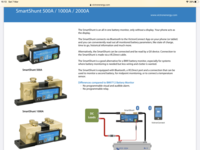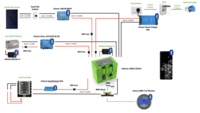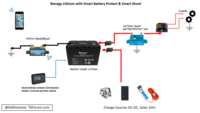Nice one! A lot of people ask me for this so you now have a nice little side line 
You are using an out of date browser. It may not display this or other websites correctly.
You should upgrade or use an alternative browser.
You should upgrade or use an alternative browser.
Diagrams, Schematics & Wires -- How I Done It --
- Thread starter Dellmassive
- Start date
Just to jump on @Dellmassive do you know of this new product ....I’m about to sort out mobile solar panels via CTEK D250sa and am looking for stand alone battery monitor
Nasa BM 1 Bluetooth (bit dated)
CTEK battery sense ( limited detail on app)
Victron ....will it cause any issue with 250sa
any thoughts please....

Nasa BM 1 Bluetooth (bit dated)
CTEK battery sense ( limited detail on app)
Victron ....will it cause any issue with 250sa
any thoughts please....

@travelvolts that was my way of thinking but it’s good to get feedback..... is it readily available yet (not much on inter web) 



Some more info here from @Dellmassive Looks like it's on Amazon.
** NEW PRODUCT **
Victron does it again . . . . . . https://amzn.to/3azIA5R
This time with the "Smart Shunt" Bluetooth battery monitor . . . . Yes Please . . .
I need one, and i need it now !!!
********************
Note that a difference between the SmartShunt and the BMV712 is that the SmartShunt has no visual or audible alarm; neither does it have a programmable relay.
All other comparisons with the BMV hold true: the SmartShunt operates in the 6.5VDC to 70VDC range; draws less than a milliamp; and monitors a battery capacity of up to 9999Ah.
********************
SmartShunt – new product launch
...the battery status monitor you view on your phone.
View attachment 62257
SmartShunt has been launched and is available in three models: 500; 1000; and 2000 Amps.
The SmartShunt is a powerful battery monitor with Bluetooth on board. It can be installed out of sight, behind the scenes – whilst live data from the device is relayed to your mobile phone or laptop via the VictronConnect App, which is free to use.
All the usual features are there – such as battery state-of-charge, voltage, current load, time-to-go – and all user-programmable settings …together with extensive historical information which allows you to analyse your system’s performance.View attachment 62258
SmartShunt can be hard-wired to any ‘GX’ device
The SmartShunt can also be connected to any device in the GX family including the Colour Control GX and the new Cerbo GX using an optional VE.Direct cable. This provides the GX device with battery data for system control – and there’s no need to find room for a BMV display.
The SmartShunt can do more than comprehensively monitor your main battery bank – additionally you can choose to either:
View attachment 62259
- monitor the voltage of a second battery – the starter battery for example
- or you can connect a temperature sensor (optional accessory) for temperature compensated charging
- or you can monitor the midpoint voltage of your battery bank (cable included) to keep an eye on battery health.
Note that a difference between the SmartShunt and the BMV712 is that the SmartShunt has no visual or audible alarm; neither does it have a programmable relay.
All other comparisons with the BMV hold true: the SmartShunt operates in the 6.5VDC to 70VDC range; draws less than a milliamp; and monitors a battery capacity of up to 9999Ah.
View attachment 62260
Included in the box are two fused-cables for +I've connection; and for second battery – or midpoint – monitoring.
Prices start at €133 / £114 / $148 for the 500A model.
Dimensions: H x W x D:
500A: 46 x 120 x 54 mm
1000A: 68 x 120 x 54 mm
2000A: 68 x 120 x 76 mm
*******************************
edit:
View attachment 62261
.
View attachment 62262
.
View attachment 62263
.
View attachment 62264
******************************
SmartShunt - new product launch | Victron Energy
SmartShunt - Victron Energy
I've just grabbed one from Amazon . . . . get yours here > https://amzn.to/38rdk7C
.
.
mrdanielmh
Member
Hi,
Apologies if this is the wrong thread so please redirect me if appropriate. I'm fitting solar panels to my T6 and want to check I'm doing the right thing before I connect it all up.
I'm putting 2 X 100W solar panels on the roof and wiring them into a Victron 75/15 charger. From there I was going to wire the battery output to the leisure battery. The van runs everything off there so should be straight forward enough, however I notice in all the wiring diagrams above you've added an isolator. Do I need to include one of these and if so why? I thought the Victron protected the battery
I then want to run a cable to the drive battery to keep it topped up. I saw on another forum that they just connected a cable from the Load output and ran it to the drive battery. I can't help thinking that that is too simple a solution. Is it really that straight forwards? If not, what should I do please? I bought the van off a guy who converted it himself so the wiring diagrams are non-existent.
Any advice appreciated please. Many thanks
Apologies if this is the wrong thread so please redirect me if appropriate. I'm fitting solar panels to my T6 and want to check I'm doing the right thing before I connect it all up.
I'm putting 2 X 100W solar panels on the roof and wiring them into a Victron 75/15 charger. From there I was going to wire the battery output to the leisure battery. The van runs everything off there so should be straight forward enough, however I notice in all the wiring diagrams above you've added an isolator. Do I need to include one of these and if so why? I thought the Victron protected the battery
I then want to run a cable to the drive battery to keep it topped up. I saw on another forum that they just connected a cable from the Load output and ran it to the drive battery. I can't help thinking that that is too simple a solution. Is it really that straight forwards? If not, what should I do please? I bought the van off a guy who converted it himself so the wiring diagrams are non-existent.
Any advice appreciated please. Many thanks
If you connect any cable directly to the battery (via a distribution post) you need at least a fuse to protect the cable should you get a chafe in the cable and it shorts to chassis. As there are hundreds of amps available from the battery, small cables will turn instantly into red hot heaters.....
Also if you have any sort of battery monitoring shunt on the battery negative, your solar ground wire should be attached to the chassis.
Also if you have any sort of battery monitoring shunt on the battery negative, your solar ground wire should be attached to the chassis.
Thanks - I'll add a fuse in the line. Is that ok in the battery compartment?If you connect any cable directly to the battery (via a distribution post) you need at least a fuse to protect the cable should you get a chafe in the cable and it shorts to chassis. As there are hundreds of amps available from the battery, small cables will turn instantly into red hot heaters.....
Also if you have any sort of battery monitoring shunt on the battery negative, your solar ground wire should be attached to the chassis.
Also how do I tell if there is a shunt? I didn't wire the base van so no sure.
Thank you for your help
Rewind here a mo. 2 x 100 watt panels will be too much for the Victron 75/15 unless you plan to wire them in series?
The 75/15 spec says it can take up to 220w or am I reading that wrong?Rewind here a mo. 2 x 100 watt panels will be too much for the Victron 75/15 unless you plan to wire them in series?
Depends on the voltage of your panel. Do you have the specs for them?
Hi, this is the spec. I had assumed imp of 5.52 x 2 is a little over 11A so under the 15 specified. Thanks
- High power models with pre wired quick-connect system with MC4 (PV-ST01) connectors
- 36 Monocristalline cells
- Module efficiency: up to 20%
- Rated power: 100W
- Max power voltage [Vmp]: 18.1V
- Max power current [Imp]: 5.52A
- Open circuit voltage [Voc]: 22.0V
- Short circuit current [Isc]: 5.85A
- Dimensions: 1350 x 540 x 3mm
- Weight 2.5 kg
Yes, it's absolutely fine. I was just being cautious as some panels have a much higher output at around 8.5 amps.
Hi Loz - Thanks for that. There is a shunt so will earth to the chassis. For my info & education, if you would, why wouldn't I earth to the bus? Its actually more difficult to do that so its just to help my understanding. The intelligence the shunt is gathering would still be protected and it would be a shorter electrical path to the battery. Appreciate the help - a clanky here working with electrickery!If you connect any cable directly to the battery (via a distribution post) you need at least a fuse to protect the cable should you get a chafe in the cable and it shorts to chassis. As there are hundreds of amps available from the battery, small cables will turn instantly into red hot heaters.....
Also if you have any sort of battery monitoring shunt on the battery negative, your solar ground wire should be attached to the chassis.
Some solar kit suppliers suggest connecting to the battery terminals and thus bypassing the shunt which means your battery monitor won't see the incoming charge just voltage rising.Hi Loz - Thanks for that. There is a shunt so will earth to the chassis. For my info & education, if you would, why wouldn't I earth to the bus? Its actually more difficult to do that so its just to help my understanding. The intelligence the shunt is gathering would still be protected and it would be a shorter electrical path to the battery. Appreciate the help - a clanky here working with electrickery!
Thank you - helpful to know. Kind regardsSome solar kit suppliers suggest connecting to the battery terminals and thus bypassing the shunt which means your battery monitor won't see the incoming charge just voltage rising.
Very helpful. How could you integrate a 230V AC hook up into this for charging? Is there any reason why a 12v output of a 230Vac -12Vdc rectifier could not connect into the DC-DC charger? Or is this an unnecessary step - could you go direct to the leisure battery terminals?Solar Panel + MPPT + Leisure Battery + Switch Panel on LOAD OP
Here we have a basic schematic, the Solar Panel via the MPPT will charge the leisure battery. The loads are connected via the MPPT LOAD OUTPUT so that if the battery power drops below a set point the LOAD OP will shut off protecting the battery.
EDIT: fuse-box feed cable now down-rated 6-10mm (but fused at 30A)
View attachment 59106
.
- Aux Lifpo4 Battery & DC-DC & MPPT & LTD & LBP -
Here we have a LifPO4 battery setup.
The DC-DC charges when engine running.
The MPPT charges when sunny outside,
Lifepo4 LTD (low temp disconnect) of DC-DC via BMV712 relay contacts.
Lifepo4 LTD (low temp disconnect) of MPPT via BMV712 Temp sensor and VE-Direct.
Lifepo4 LBP (Low battery protect) via Victron 100A Smart battery protect.
****************************************************************************************
View attachment 57457
.
**********************************************************************************************
next
**********************************
Last edited by a moderator:
Similar threads
- Replies
- 6
- Views
- 1K
- Replies
- 46
- Views
- 2K
- Replies
- 24
- Views
- 2K
- Replies
- 11
- Views
- 897



